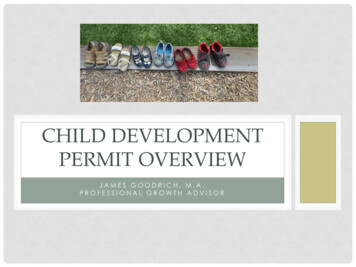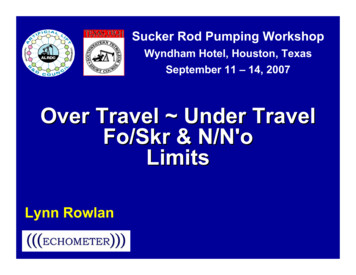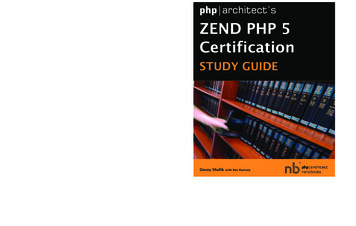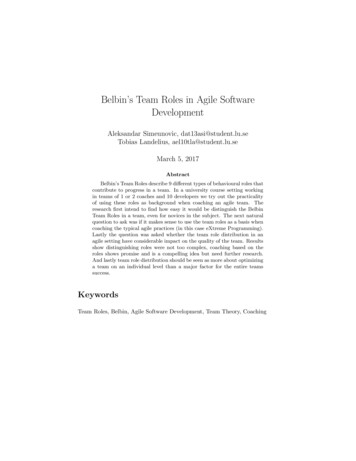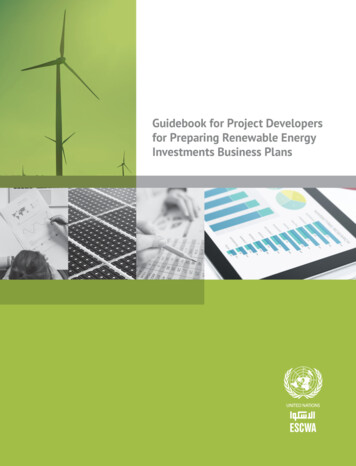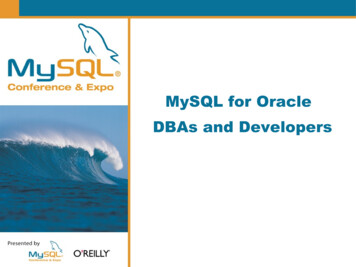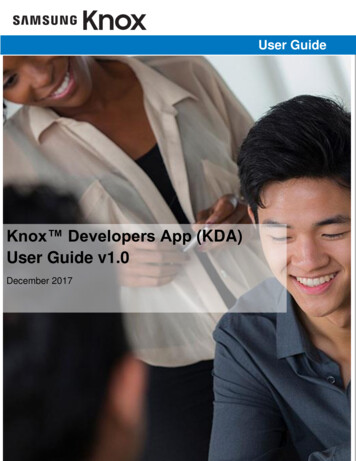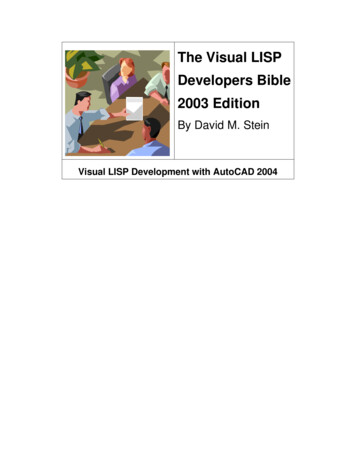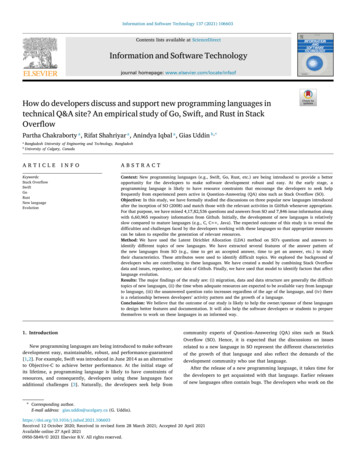
Transcription
Information and Software Technology 137 (2021) 106603Contents lists available at ScienceDirectInformation and Software Technologyjournal homepage: www.elsevier.com/locate/infsofHow do developers discuss and support new programming languages intechnical Q&A site? An empirical study of Go, Swift, and Rust in StackOverflowPartha Chakraborty a , Rifat Shahriyar a , Anindya Iqbal a , Gias Uddin b , abBangladesh University of Engineering and Technology, BangladeshUniversity of Calgary, CanadaARTICLEKeywords:Stack OverflowSwiftGoRustNew languageEvolutionINFOABSTRACTContext: New programming languages (e.g., Swift, Go, Rust, etc.) are being introduced to provide a betteropportunity for the developers to make software development robust and easy. At the early stage, aprogramming language is likely to have resource constraints that encourage the developers to seek helpfrequently from experienced peers active in Question–Answering (QA) sites such as Stack Overflow (SO).Objective: In this study, we have formally studied the discussions on three popular new languages introducedafter the inception of SO (2008) and match those with the relevant activities in GitHub whenever appropriate.For that purpose, we have mined 4,17,82,536 questions and answers from SO and 7,846 issue information alongwith 6,60,965 repository information from Github. Initially, the development of new languages is relativelyslow compared to mature languages (e.g., C, C , Java). The expected outcome of this study is to reveal thedifficulties and challenges faced by the developers working with these languages so that appropriate measurescan be taken to expedite the generation of relevant resources.Method: We have used the Latent Dirichlet Allocation (LDA) method on SO’s questions and answers toidentify different topics of new languages. We have extracted several features of the answer pattern ofthe new languages from SO (e.g., time to get an accepted answer, time to get an answer, etc.) to studytheir characteristics. These attributes were used to identify difficult topics. We explored the background ofdevelopers who are contributing to these languages. We have created a model by combining Stack Overflowdata and issues, repository, user data of Github. Finally, we have used that model to identify factors that affectlanguage evolution.Results: The major findings of the study are: (i) migration, data and data structure are generally the difficulttopics of new languages, (ii) the time when adequate resources are expected to be available vary from languageto language, (iii) the unanswered question ratio increases regardless of the age of the language, and (iv) thereis a relationship between developers’ activity pattern and the growth of a language.Conclusion: We believe that the outcome of our study is likely to help the owner/sponsor of these languagesto design better features and documentation. It will also help the software developers or students to preparethemselves to work on these languages in an informed way.1. IntroductionNew programming languages are being introduced to make softwaredevelopment easy, maintainable, robust, and performance-guaranteed[1,2]. For example, Swift was introduced in June 2014 as an alternativeto Objective-C to achieve better performance. At the initial stage ofits lifetime, a programming language is likely to have constraints ofresources, and consequently, developers using these languages faceadditional challenges [3]. Naturally, the developers seek help fromcommunity experts of Question–Answering (QA) sites such as StackOverflow (SO). Hence, it is expected that the discussions on issuesrelated to a new language in SO represent the different characteristicsof the growth of that language and also reflect the demands of thedevelopment community who use that language.After the release of a new programming language, it takes time forthe developers to get acquainted with that language. Earlier releasesof new languages often contain bugs. The developers who work on the Corresponding author.E-mail address: gias.uddin@ucalgary.ca (G. 3Received 12 October 2020; Received in revised form 28 March 2021; Accepted 20 April 2021Available online 27 April 20210950-5849/ 2021 Elsevier B.V. All rights reserved.
Information and Software Technology 137 (2021) 106603P. Chakraborty et al.new languages are likely to face problems that are similar to the solvedproblems of mature languages. Developers of the new languages oftenfeel the absence of a library or feature that has already been availablein other languages. Therefore, the discussions on a new language arelikely to differ from that of a mature language. To the best of ourknowledge, there is yet to be any software engineering research thatfocuses on the specific characteristics of the new languages by miningrelevant discussions from SO.In this study, we would like to fill this gap, analysing the discussionson Swift, Go, and Rust that are the most popular programming languages introduced after the inception of SO (2008). Our study is limitedto these three languages because other new languages have very smallfootprints in SO. Being born after SO, the evolution of these languages,right from the beginning, is expected to be reflected in SO. From nowon, by the new language, we imply Swift, Go, and Rust languages. Wealso match the SO discussions with the relevant activities in GitHub inthe required cases.The primary goal of this research is to study how software developers discuss and support three new programming languages (Go, Swift,Rust) in Stack Overflow. On this goal, we conduct two studies: (1)Understanding New Language Discussions: We aim to understand whattopics developers discuss about the three new programming languages,whether and how the topics are similar and/or different across thelanguages, and how the topics evolve over time. (2) Understanding NewLanguage Support: We aim to understand what difficulties developersface while using the three new languages, and when and how adequateresources and expertise become prevalent to support the three newprogramming languages in Stack Overflow. In particular, we answerfive research questions around the two studies as follows.development. We have seen that two years after the release,sufficient resources can be expected for Swift, whereas thisperiod is three years for Go. We have also found the evidenceof having an inadequate resource of Rust language in StackOverflow.RQ5. Is there any relationship between the growth of the threeprogramming languages and developers’ activitypatterns? This question investigates the relationship betweendevelopers’ activity (e.g., question, answer) and the growth ofa language. Language projects maintain a Github repositorythat supports feature requests [4] and bug reports throughGithub issues. We used those issues as an indirect measure forlanguage growth. We found evidence of relationships betweendevelopers’ activity and the growth of a language.Our findings show that questions related to ‘‘migration’’ are common among new languages. To facilitate developer efforts, platformowners should provide detailed documentation of steps to migrate fromconventional sources. In this study, we identified the duration, afterwhich adequate resources become available in SO. This finding canhelp developers to make any decisions regarding migration to a newlanguage. In addition, language owners should provide support untiladequate resources become available in the QA community. Moreover,our study identifies some of the factors that influence the evolution ofnew languages. The finding can help language owners to prioritize theirgoals.A preliminary version of this paper appeared previously as a shortconference paper [5]. The only overlap between the previous paper [5]and the current paper is Research Question 4, i.e., ‘When were adequate resources available for the new programming languages in StackOverflow?’.Paper Organization. The rest of the paper is organized as follows.Section 2 describes the background of our study and the data collectionprocedure. Section 3 reports the research questions about developers’ discussion. Section 4 presents the research questions about thedevelopers’ support to the three new languages. Section 5 discussesthe implications of our findings. Section 6 discusses the threats tovalidity. Section 7 presents the related work to our study, and Section 8concludes the paper. Study 1. New Language Discussions: We answer two researchquestions:RQ1. What topics are discussed related to Swift, Go, and Rust?This investigates the discussion topics of the developers of newlanguages. Identification of the discussion topics may help thesponsor to design a feature roadmap that actually facilitatesthe requirement of developers.RQ2. How do the discussed topics evolve over time?The community’s discussion topics is likely to vary over time,as resources evolve continuously. This analysis would enableus to investigate any possible relation between discussion topics and real-world dynamics, such as new releases. We foundthat a new release does not initiate any significant change inthe evolution of discussion topics.2. Background and data collection2.1. Stack Overflow Q&A siteQ&A sites have become very popular in recent years. There areseveral Q&A sites that programmers use to ask questions, solve problems they encounter, provide answers to other people’s problems, anddiscuss different approaches. Stack Overflow is the most popular ofthese sites. Since its inception in 2006, it has become a popular andreliable platform for sharing knowledge among programmers. As aresult, Stack Overflow has plenty of resources for programmers on avariety of topics. From the beginning to 2020, 49,53,854 developershave asked 2,01,28,125 questions on 59,524 different topics in thestack overflow. Study 2. New Language Support: We answer three research questions:RQ3. How does the difficulty of topics vary across the languages?Developers of new languages face problems that are rarelyanswered or get delayed answers. By the delayed answer, weimply that answer which is accepted by the user and receivedafter the median answer interval of that month. We want toknow about these questions so that special measures can betaken to answer this question. We found that questions relatedto migration, data and data structure are considered as difficulttopics in all three languages.RQ4. When were adequate resources available for the new programming languages in Stack Overflow?In this research question, we want to know the time interval,after which we can expect the availability of these resourcesof new languages in Stack Overflow at a satisfactory level. Theuse of programming languages is significantly related to theavailability of resources of those languages. This question willhelp developers to make design decisions related to software2.2. New programming languages discussions in Stack OverflowAbout 37 [6] programming languages have been released after theinception of Stack Overflow in 2008. Most of the new languages (released after 2008) have a little footprint in SO, which is insufficient toformally analyse the interaction between developers and programminglanguages. For selecting the language, we have used the SO survey [7]and the newly released language list [6]. In Table 1, we show thefootprints of the languages in SO. To do a comparative analysis of theevolution with three new languages, we picked one high footprint language (Java) and one medium footprint language (Python). Javascript2
Information and Software Technology 137 (2021) 106603P. Chakraborty et al.Table 1Stack Overflow footprint of programming languages.aLanguageTotal post countJavascriptJavaPhpC SwiftaPythonGoaRustaKotlinaDartaBallerinaa4 875 127(10.6399%)4 101 937(8.9524%)3 515 748(7.673%)2 575 423(5.6208%)538 542(1.1754%)276 022(0.6024%)91 460(0.1996%)23 .3.1. Download Stack Overflow datasetFor our analysis, we have collected the January 2018 Stack Overflow data dump, which is available in the Stack Exchange data dump.In Stack Overflow schema, both question and answer are considered aspost. The post table of the data dump contains all the information of apost like a title, tags, body, creation date, view count, type (questionor answer), and accepted answer identifier. An answer is accepted ifthe questioner marks that answer as accepted. Our dataset includes4,17,82,536 questions and answers posted over 9 years from August2008 to January 2018 by 39,40,962 users of Stack Overflow. Amongthese posts 1,63,89,567 (39%) are questions and 2,52,97,926 (61%) areanswers of which 87,04,031 (21%) are marked as accepted answers.Released after 2008.2.3.2. Develop tag setTo compare the growth of languages, we have to separate the postsby language. Posts on Stack Overflow can be about any topic, andwe need a way to identify posts by language. Every Stack Overflowpost is associated with at least one tag. We consider a post associatedwith one of the new languages if that contains at least one tag of therespective language tag. We have created an initial set of tag 𝜏0 for eachof the languages. One of the authors checked the initial tagset. LikeVásquez et al. [2], we scaled down the full Stack Overflow (SO) tag setby performing a wildcard query (e.g.; ‘‘SELECT * FROM Tags WHERETagName like ‘%swift%’ order by Count desc’’). After that, the searchspace becomes feasible to perform a manual inspection. The initialtagset is available at GitHub. Next, we go through the Stack Overflowdataset and extract questions 𝜌 whose tags contain a tag from 𝜏0 .Third, we extract tags of the posts in 𝜌 to form the set of candidatetags 𝜏. Now we have a set of tags 𝜌 for each language, which includesall tags of that language. However, set 𝜌 may include tags that may beirrelevant to new languages. Hence, following the approach of Rosenet al. [8], we have used two heuristics, 𝛼 and 𝛽, to find the significantlyrelevant tags for each language.𝑛𝑢𝑚𝑏𝑒𝑟 𝑜𝑓 𝑝𝑜𝑠𝑡𝑠 𝑤𝑖𝑡ℎ 𝑡𝑎𝑔 𝑡 𝑖𝑛 𝜌𝑛𝑢𝑚𝑏𝑒𝑟 𝑜𝑓 𝑝𝑜𝑠𝑡𝑠 𝑤𝑖𝑡ℎ 𝑡𝑎𝑔 𝑡 𝑖𝑛 𝑛𝑢𝑚𝑏𝑒𝑟 𝑜𝑓 𝑝𝑜𝑠𝑡𝑠 𝑤𝑖𝑡ℎ 𝑡𝑎𝑔 𝑡 𝑖𝑛 𝜌𝛽 𝑛𝑢𝑚𝑏𝑒𝑟 𝑜𝑓 𝑝𝑜𝑠𝑡𝑠 𝑖𝑛 𝜌𝛼 (1)(2)We have experimented with a broad range of 𝛼 and 𝛽 and foundthat 𝛼 0.01 and 𝛽 0.01 provides a significantly relevant set of tags.The values are consistent with previous research on finding tags for bigdata or concurrency tags [9,10]. The tag set used to extract posts in thisstudy is available at GitHub.Our new language tag set is extensive and covers a large spectrumof tags related to new languages. The name of language or languageversions is a highly relevant tag to identify posts. Swift 2.1, go, and rustare this kind of tag in our tag set. In terms of relevance, the next typeof tag is the name of a library/framework with or without a version.As these libraries/frameworks are applicable to a particular languagethey can be used to identify the post of that language. These types oftags in our tag set are grails2.0, beego, cocoa, rust-tokio, etc. The thirdtype of tag is named after a specific feature of the language. Goroutine,unmarshalling, traits are such kind of tag in our tag set. In additionto highly focused tags, our tag set also includes generic tags such asconcurrency, protocol.Fig. 1. An overview of the methodology of our study.has the highest footprint, but it is primarily used for web clients only.We have selected Java as the representative of top-tier languages dueto its wide range of use. We have selected Python as the representativeof mid-tier languages due to its recent emergence.2.3. Data collectionThe following steps are carried out to develop the dataset for thisstudy:2.3.3. Extract posts of new languagesUsing the tag set prepared in the previous step, we have separatedthe posts by language. We have 4,37,880 Swift posts, consisting of1,88,065 (43%) questions and 2,49,815 (57%) answers of which 94,310(21.6%) are accepted answers. We have 72,843 Go posts, consisting of30,286 (41.6%) questions and 42,557 (58.4%) answers of which 19,178(26.3%) are accepted answers. We have 18,311 Rust posts, consistingof 8083 (44.1%) questions and 10,228 (55.9%) answers of which 5964(32.6%) are accepted answers.1. We download the SO dataset,2. We identify list of tags related to the three languages in SO,3. We extract all questions and accepted related to the list of tags fromSO,4. We extract issues reported to the GitHub repositories of the threelanguages.Fig. 1 shows an overview of the methodology of our study. We explainthe steps below.3
Information and Software Technology 137 (2021) 106603P. Chakraborty et al.2.3.4. Preprocess new language post setIn this step, posts of the new language are preprocessed to reducenoise. The preprocessing steps include the removal of code segments,HTML tag, and URL, exclusion of stop words (e.g., a, the, is), and wordstemming. We have used porter stemming for converting the word intotheir root form.accordingly, it would be helpful for the sponsors of those languages.The lack of resources (such as proper documentation) will be revealedfor the most visited topics, and the relevant people may address thosein an organized way. Hence, our first research question is intended toanalyse these languages’ discussions by dividing these into differenttopics and categories.2.3.5. Model and label new language topicsIn this step, we use the Gensim implementation of latent Dirichletallocation (LDA) to identify new languages’ topics. Previous studieshave pointed that LDA topics may be subject to change if the orderof documents is changed. Thus we have used a differential evolutionalgorithm to select LDA parameters. This approach has made our topicsmore stable. After extracting the topic, we manually labelled the topicswith an appropriate title.3.1.2. ApproachWe used LDA to identify the topics of developers’ discussion. LDA(Latent Dirichlet Allocation) is a generative statistical model commonlyused for topic modelling [11]. In LDA, it is assumed that each documentis a mixture of a small number of topics. It is believed that LDA topicsare related to the order of documents in the dataset. If the order ischanged, the topics will likely be changed. We have calculated the Rawscore for LDA topics to mitigate the risk. The raw score is a modifiedversion of the Jaccard Index. In calculating the raw score, the LDAparameters are kept constant, and the data orders are changed. Thisprocess is repeated 10 times to identify the raw score of LDA for oneset of parameters. To ensure topic stability and determine the best LDAParameters, we filled up the LDA parameters with a set of arbitraryvalues and calculated the raw score for each group. Using the best (interms of raw score) parameters of the current run, the second run starts.This process has been continued for three generations, and we receivedthe best stability ensuring the LDA parameter. Next, using those parameters, we run the LDA. From LDA, we received a set of keywordsfor each topic. To label the topics, we identified the dominant topic ofall the posts. Next, for each topic, we continued the following labellingstrategy. First, we randomly selected twenty posts, where the dominanttopic is this topic. Then we manually analysed the topic keywordsalong with the posts and labelled the topics. The first author mergedthe topics into higher level categories first. Then it was reviewedby the second and third authors. The issues identified were resolvedby a detailed discussion involving all the authors. Furthermore, wehave extracted some of the features of the adopted topics in priorworks [9,10,12] to measure popularity.2.3.6. Calculate topic absolute impactThe absolute topic impact shows the absolute proportion of a particular topic in a particular month’s posts. In this step, the absolute impactof topics are calculated using Eq. (5).2.3.7. Calculate topic popularity & difficultyIn this step, for each topic, we have extracted the number ofposts without accepted answers and the median time to answer. Laterwe have calculated the correlation between without accepted answerpercentage and the median time to answer.2.3.8. Calculate quality score and interaction scoreWe have calculated the quality score and interaction score for eachlanguage using Eqs. (7) and (6). After that, we used the scores todetermine the stable point date, a date after which sufficient resourceswould be available in the SO.2.3.9. Data extraction from Github & model developer activityGitHub provides access to data of public repositories and usersthrough its public API. The new languages have their official repositoryin GitHub. In this step, we have collected the creation date and closingdate of all the issues from these new languages’ official repositories.GitHub issues have two states, ‘open’ and ‘closed’. As soon as an issueis taken care of, it changes its state from ‘open’ to ‘closed’. We collectedstates and frequencies of the issues. Then for each month, we collectedthe number of repositories and users of each new language. Github setsthe dominant programming language of a repository as the language ofthat repository. We have used Github Search for collecting repositoryand user count. Using that specific search language, one can searchand count the repositories of a particular language. We have queriedfor each month and each of the languages. In the search process, wehave excluded the fork repositories. Another part of Github data wasusers. To collect user data, we have collected all the repositories of aparticular language, and then we collected the unique committers ofthose repositories. After finding those committers, we collected theirjoining date and counted the number of users joined each month. Thenumber of repositories and users we have checked are presented inFig. 2. Then we used regression to model developers’ activity. Average view of post: SO collects view counts for each post. Usingthis metric, we can get an indication of the public interest. Theintuition is that if many developers view a post, then this post is eithervery popular or the problem is common among the developers of newlanguages. For this reason, we have collected average views for eachtopic. Average number of post count as favourite In SO, users canmark a post as a personal favourite if the post is helpful. Favouritefacility notes things that are important or interesting to developers.Developers can return to their favourite posts from the favourite tabin Stack Overflow. We collected the average favourite count for eachtopic in the new language. The metric will reveal how helpful/alignedthe posts are with the developers’ goals. Average Scores: In SO, an interesting/unique question or best solution can be rewarded by upvote. Where the attribute ‘‘favourite’’expresses developers’ individual choice, upvote tells the fellow developers whether the post is useful or not. SO then aggregates thevotes (summation of the upvotes less than the summation of thedownvotes) and presents them as scores. In this study, we summed upall posts’ scores and divided them by the number of posts to calculateeach topic’s average score. This score of each topic will be used asmetrics of perceived collective values.3. Developers’ discussions about the three new languages3.1. RQ1. What are the topics of discussions related to Swift, Go, and Rust?3.1.1. MotivationIn this work, we explore the SO footprint of three new languagesintroduced after SO and become popular in the developer communityfor knowledge sharing. Hence, it is likely that the issues developersface while working with these languages will be reflected in the postsand discussions on these languages in SO. If the queries are organizedaccording to topics and characteristics of the responses are analysed3.1.3. ResultThe raw score of our approach presents the stability of the topicsidentified by LDA. The higher the raw score, the higher the stability.In this study, we have used three words while calculating the rawscore. The raw score achieved in our study is presented in Table 2. Wealso calculated the topic coherence score for our LDA model. The topiccoherence score measures the quality of the extracted topics [13]. The4
Information and Software Technology 137 (2021) 106603P. Chakraborty et al.Fig. 2. # of Repositories and Users checked from Github.Fig. 3. Swift topics and number of their questions.Fig. 4. Go topics and number of their questions.5
Information and Software Technology 137 (2021) 106603P. Chakraborty et al.Fig. 5. Rust topics and number of their questions.Table 2Raw score achieved by our approach.through the popularity metrics: views, likes, and scores received fromusers in Stack Overflow.LanguageRaw scoreSwiftGoRust0.880.880.66Swift topicsThe percentage of Swift posts related to each topic is presented inFig. 3. From Table 4 we can observe that 5 of the 18 topics of Swiftare related to UI. They are User Interface, View Controller Lifecycle,UI constraint, Gesture Recognition and Graphics. These topics includequestions like, (a) how a specific UI functionality can be achieved, (b)how to use multiple UI components together, (c) how the life cycleof view controller that manages applications UI interface changes, (d)using 2D and 3D graphics components for game development, etc. Morethan 17% of the Swift related posts are on these topics. An exampleof posts under this topic is a developer asking on Stack Overflow, ‘‘Iam making a game on Xcode using sprite kit it is, and I need to addan angry bird slingshot like to the ball, I don’t know how can I applyit’’. Swift is mainly used to develop iOS applications and games withstate-of-the-art user interfaces. As a result, UI related posts are generallyhigher for Swift.Table 3Coherence score of the topics.LanguageCoherence scoreSwiftGoRust0.590.560.49higher the coherence score, the higher the quality of topics. The topiccoherence score is presented in Table 3. Tables 4, 5, and 6 shows thediscussion topics for each language sorted in terms of average views. Italso shows the number of posts related to each topic and its popularityTable 4Swift topics, categories, and their popularity.CategoryTopicAvg. ViewsAvg. FavouriteAvg. Score#PostsApplicationRequest handlingUse of simulatorError handlingTestingCross platform toolsSensor 0.410.520.410.650.60.621.171.51.562.331.71.6515 17111 81916 2336956718217 914Data& Data structurePortable databaseSerializationType 3.3313 79010 20115 347Library/SDKFoundation kitUse of CoreSpotlightSDK/Library 2.9311 218927413 916MigrationMigration1408.090.732.6913 651UIGraphicsUser interfaceView controller lifecycleUI constraintsGesture 10.370.420.541.20.851.081.361.7313 18513 88716 92714 59480716
Information and Software Technology 137 (2021) 106603P. Chakraborty et al.Table 5Go topics, categories, and their popularity.CategoryTopicAvg. ViewsAvg. FavouriteAvg. Score#PostsApplicationWebserverTemplate 812.684.432322269789Build compilationBuild/Compilation error1880.50.922.85844Data & Data structureDatabase and ORMType 888.080.350.911.511.363.38.1149333493227I/OI/O operation1767.060.742.548263Library/SDKLibrary integration error1858.890.72.457963MemoryMemory 882.277.44128ParallelismGo channelGo routine1222.281729.490.680.9722.9623011823Table 6Rust topics, categories, and their popularity.CategoryTopicAvg. ViewsAvg. FavouriteAvg. Score#PostsData & Data structureBorrow mechanismUse of TraitMutabilityGeneric codingUse of ry/SDKCargo782.680.563.661205MigrationMigration problem8370.554.55520ParallelizationMutexParallel execution675.14678.570.360.412.813.2666579the title of this question. When I replace the string ‘resortName’ with‘location’ and store the whole object instead the error goes away’’.The Foundation Kit is a fundamental framework that is quite old andmature, so the number of questions (posts) will likely be lower.3 of the 18 topics of Swift are related to Data and Data Structure.They are Data Handling, Type Conversion, Mutability, and Database.These topics include questions like, (a) how to save, stream or receivevideo data from the network, (b) how to perform custom data typeconversion and how to write proper syntax for typecasting, (c) the useand syntax of immutable data, (d) how to perform CRUD and other datamanipulation operation in the portable database and correspondingframework provided by Swift, etc. More than 17% of the Swift relatedposts are on these topics, and more than 6% of them are related todata type conversion. The posts related to data type conversion havethe highest average score (3.1) among the Swift posts, meaning theposts’ answers are generally helpful to the developers. An example ofposts under this topic is a developer asking on Stack Overflow, ‘‘I ambit confused with typecasting in Swift. Have a small doubt. What isthe difference between ‘as?’, ‘as!’ and only ‘as’. And can we say ‘as’ issimilar to ‘is’’’.About 6% of the Swift related posts are related to Migration. Thistopic includes questions for two types of migration problems, (a) whenthe developers face problems to recreate something in Swift whilemigrating from another language, mostly from Objective-C, and (b)when the developers face problems in XCode while migrating froman object project. An example of posts under this topic is a developerasking on Stack Overflow, ‘‘I’m not sure if this is something to do withSWIFT or some bug, but I used to be able to call this in objective c’’.Objective-C is the predecessor language of Swift, and
Swift Go Rust New language Evolution A B S T R A C T Context: New programming languages (e.g., Swift, Go, Rust, etc.) are being introduced to provide a better opportunity for the developers to make software development robust and easy. At the early stage, a programming language is l

